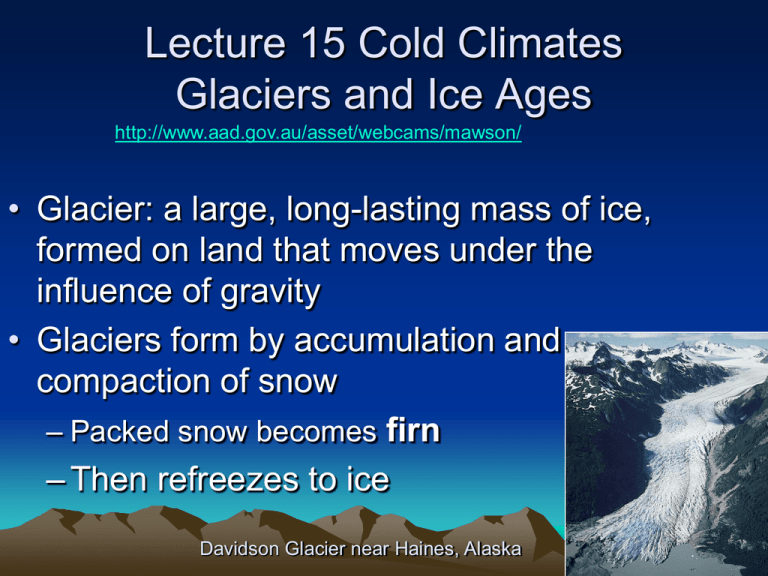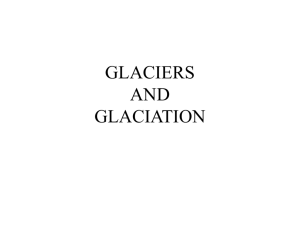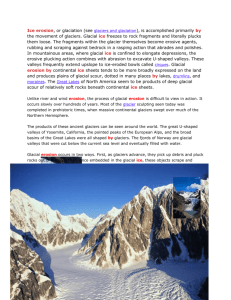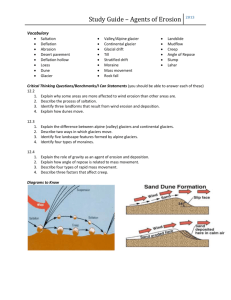Lecture 15 Cold Climates s
advertisement

Lecture 15 Cold Climates Glaciers and Ice Ages http://www.aad.gov.au/asset/webcams/mawson/ • Glacier: a large, long-lasting mass of ice, formed on land that moves under the influence of gravity • Glaciers form by accumulation and compaction of snow – Packed snow becomes firn – Then refreezes to ice Davidson Glacier near Haines, Alaska Formation of Glacial Ice from Snow snowball iceball Alpine Glacier: it is just a frozen river Types of Glaciers Continental Alpine Alpine glaciation: found in mountainous regions Continental glaciation: exists where a large part of a continent is covered by glacial ice Cover vast areas Alpine Glaciers– Cirque Glacier Mount Edith Cavell, Jasper National Park, Canada Alpine Glaciers – Valley Glacier Lateral and medial moraines Tongas National Forest, Alaska Types of Glaciers – Icecap and Continental http://www.nmm.ac.uk/server/show/conWebDoc.1221 Sentinal Range, Antarctica •Antarctica is the broadest high place on Earth, the ice cap is up to 4km thick and covers the continent •Antarctica is a desert, with only 15 cm (6 inches) of snowfall a year around the South Pole. The air is too cold to hold much moisture. •The lowest recorded temperature is -89.2 °C. •There is no life in Antarctica except near the coast http://www.aad.gov.au/asset/webcams/mawson/ Types of Glaciers – Piedmont & Tidewater Piedmont: Originally confined alpine, spread at foot of mountains Source: Jim Wark/Peter Arnold, Inc. Calving Iceberg Calving – Hubbard Glacier, Wrangell-St. Elias National Park, Alaska A Glacier’s Budget • Budget = Gain – Loss • Gains snow in zone of accumulation • Loses ice in zone of ablation • Budget can be positive (net growth) • Static • or negative (net melting) A Glacier’s Budget Year round Snow Summer Rain Note that a glacier is a river. Even if the terminus doesn’t advance, it still flows downhill Mechanics of Glacial Flow Internal deformation Ice crystals slide past one another Basal Sliding Entire glacier slides downhill on a thin film of meltwater at its base. Glacier always flows toward zone of ablation Erosion 1: Glacial Abrasion in Bedrock Glaciers cause erosion Rock embedded in Ice Source: Tom Bean Glacial Erosion – Roche Moutonée 2. Quarrying FROST WEDGING Glacial Erosion – Roche Moutonée Yosemite NP, Calif Erosion by Glaciers (cont.) • Alpine glaciers erode mountain slopes into horseshoe shaped basins called cirques – Melting forms cirque lake (tarn) • Erosion of two or more cirques erodes intervening rock – Horns :pointy peaks made by trios – Arêtes: long serrated ridges by pairs – Cols: passes through the arêtes Alpine Glacial Erosion Cirque and valley glaciers form in river valleys, cut U-shapes Alpine Glacial Erosion Cirque glaciers erode uphill, widen Valley glaciers enlarge Arêtes, Horn, Col, HANGING VALLEYS Yosemite Falls from Hanging Valley U-Shaped Glacial Valley in Southeastern Alaska Valley glaciers erode a large quantity of bedrock and sediment Convert V-shaped stream valleys into U-shaped glacial valleys. Seawater Flooded U-Shaped Valleys: Fjords Bela Bela Fjord, BC Sea Level rose as glaciers melted Erosion by Continental Glaciation • Erosional Landforms much larger in scale than alpine glaciers –Whalebacks – huge Roche Moutonée –Huge U-shaped troughs – Finger Lakes, Great Lakes, Puget Sound, Loch Ness were all once stream valleys excavated by Ice Sheets Erosion by Continental Glaciation (Great Lakes, Finger Lakes) Superior M i c h i g a n Huron Ontario Erie Source: U.S. Dept. of Interior, USGS Eros Date Center Glacial Deposits - Drift • Collectively called Glacial Drift • TYPE 1: UNSORTED • Glacial Till: unsorted, unstratified sediments deposited by melting ice. – May contain glacial erratics – Often accumulates at glacier’s terminus as a Terminal Moraine: hills of sediment left by a glacier’s retreat. – Moraines may be reshaped by a later glacial advance into Drumlins: rounded elongated hills Advance & Retreat: Moraines Note moraine, no matter direction Analogy: Escalator Discussion: Advance & Retreat of Glaciers and Terminal Moraines Large Granite Erratics Favored by climbers with families Medial Moraines Wrangell-St. Elias NP, SE AK Medial Moraines – Kennicott Glacier The Origin of Drumlins Glacier retreats, leaving a terminal moraine. Then it advances again, and redistributes the drift as a spoon shaped hill called a drumlin. Drumlins Rochester,NY Glacial Deposits - Drift • TYPE 2: SORTED • Outwash: sorted stratified sediments deposited by meltwater streams • Loess: wind erosion of drying outwash silt. • Eskers: sinuous meltwater deposits of sand and gravel underneath ice Origin of Eskers Eskers and Kettles in South Dakota Effects of Glaciation • Change Climate – increase precipitation pluvial lakes • Depress continents & lateral rebound • Drop sea-level: alter coastlines • Moraines form Dams – Proglacial Lakes – Divert streams – Ohio and Missouri rivers Formation of Terraces due to Crustal Rebound Lowered Sea-level - Land bridge Bering Glacier grows, sea-level drops Lowered Sea-level exposed continental shelf Massive extinctions of shallow-water marine organisms The Creation of Glacial Lake Missoula Purcell Lobe blocks Clark Fork River The Draining of Glacial Lake Missoula Repeated many times, last time 13000 kya Giant Ripples of the Missoula Flooding Flood kills everything in its path, 26 times Giant Ripples Country road for scale Max Glacier Distribution 20,000 ya Maximum glaciation occurs at coincidence of three astronomical cycles if high land in polar latitudes Causes of Ice Ages • Plate Tectonics Moves Continents to Poles Raises mountains above snowline Albedo increases, colder, spread • Orbit distance, Axis Tilt and Wobble – Moderates solar radiation past 65o Latitude – Croll-Milankovitch Cycles ~ every 100,000 years – With many smaller cycles between – Need low summertime radiation past 65o Latitude less melting, glaciers expand Milankovitch Cycles http://en.wikipedia.org/wiki/Milankovitch_cycles The energy of solar radiation drops off as the square of the distance Further away 100,000 years Not as hot High latitude getting more sunlight in winter Warm Wet Winter Cool Summer Snow doesn’t melt Glaciers grow High latitude getting less sunlight in summer Cold Dry Winter Hot Summer Snow melts Glaciers shrink High latitude getting more sunlight in summer 41,000 years at Perihelion at Perihelion Determines which hemisphere gets conditions suitable for glaciation 25,700 years One More Point On This • The orbital affects that Milankovitch suggested as a partial cause for ice ages each have a different period. • They combine at irregular intervals • Many glaciation peaks are about 100,000 years apart, but that is ONLY an average. This suggests that orbital ellipticity is important. The worst glaciations occur when minimum tilt coincides with maximum ellipticity. Earth’s Past Ice Ages Cenozoic Mesozoic Paleozoic Paleozoic • Tertiary to Quaternary cooling – Pleistocene • None in Mesozoic • Late Pennsylvanian & Permian in southern continents (Gondwana) • Ordovician glaciation (Gondwana) – Area that is now the Sahara at South Pole PreCambrian • PreCambrian Tillites (Lithified Till) – Three, maybe four,episodes – Oldest 2.8 bya – 750 mya ice from poles to tropic “Snowball Earth” Permian Glaciation – Gondwana Tillites Cenozoic Cooling Southern Ocean forms Central America Forms Foraminifera tests Ice Age Warm Cold Wisconsinan Illinoian About 30 pulses in 4 or so major groups Kansan Nebraskan 3. Also spiral direction & diversity depends on Temp. 1. Evap. water and CO2 removes 16O from oceans 18O left in oceans used to make shells 2. Ice traps CO2 and water with light oxygen Continuous Ice Sheet 20 kya Scoured 30 M below sea-level Global Temperatures Cycle, largest 100,000 Year (orbit eccentricity) Smaller signals about 25K and Interglacials get really WARM 41K http://en.wikipedia.org/wiki/Little_Ice_Age The Holocene • Latest retreat began 10,000 years ago • Climate varied. Hot 8000 – 4000 ya • Medievil Warm: 800 – 1200 AD • • • • Little ice age 1200 AD until 1850 Widespread Famine 1253 Pueblo cliff-dwellings abandoned. 1340s AD Black Death Bubonic Plague Holocene Temperature Variations Mann’s Hockey Stick +1 2004 o C Water freezes -1 12 6 Thousands of Years BP 0 http://en.wikipedia.org/wiki/Image:Holocene_ Temperature_Variations.png Sustained warming since 1850 Athabaska Glacier, Columbia Icefield, W. Canada 2005 Greenland glacier retreated 9 miles! Antarctic Glaciers started melting this season








